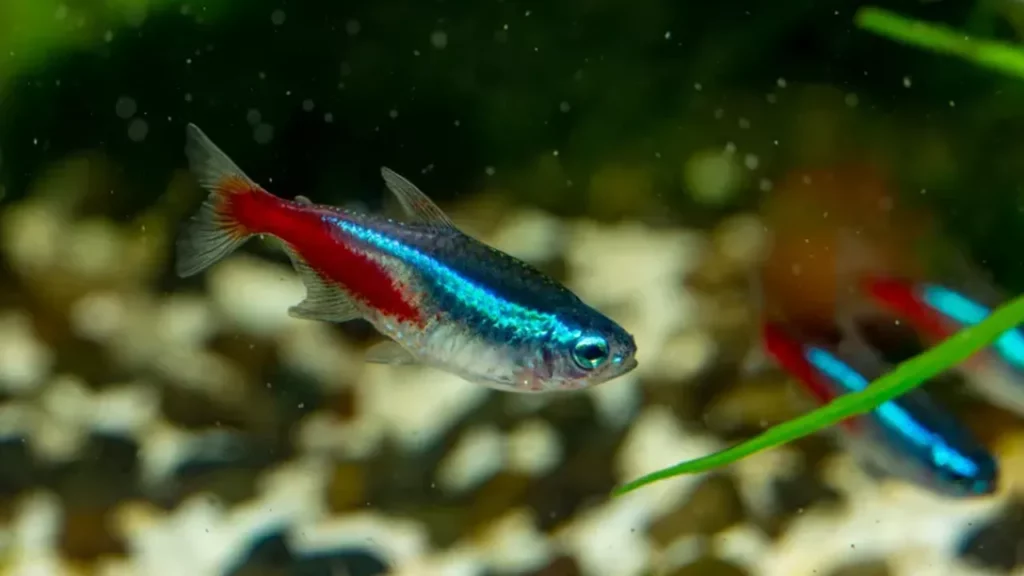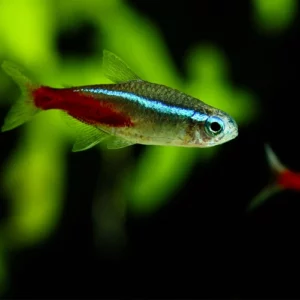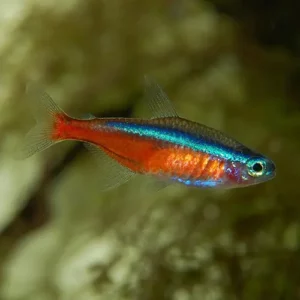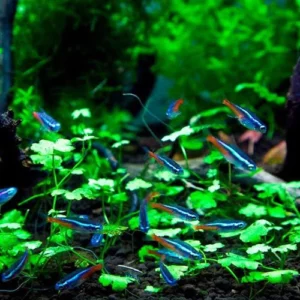Can Neon Tetras Live With Betta? Yes And How
Yes, bettas can live harmoniously with neon tetras. Neon tetras, being schooling fish with a generally peaceful temperament, can coexist with the more territorial bettas, especially when housed in a sufficiently spacious tank, like a 20-gallon setup. The two species naturally occupy different swimming zones, with neon tetras preferring mid-water and bettas gravitating towards the surface. Their non-competing appearances, coupled with the protective nature of a large tetra school, reduce potential conflicts. However, it’s essential to provide ample hiding spots, plantations, and monitor their interactions, especially during betta breeding phases, to ensure a peaceful coexistence.
Home » Guides » Fish Care » Neon Tetra » Can Neon Tetras Live With Betta? Yes And How
Neon Tetra Fact Sheet
| Scientific Name | Paracheirodon innesi |
| Common Name | Neon Tetra, Neons |
| Care Difficulty | Easy |
| Life Expectancy | 3-10 Years |
| Average Size | 1.5 Inches (3.8cm) |
| Temperature | 72°F – 82°F (22°C -28°C) |
| Diet | Omnivore |
| Behavior | Friendly/Peaceful |
| Breeding | Medium/Hard |
| pH | 6-7.5 |
| Live Plant Friendly | Yes |
Understanding the Basic Behavior of Both Species
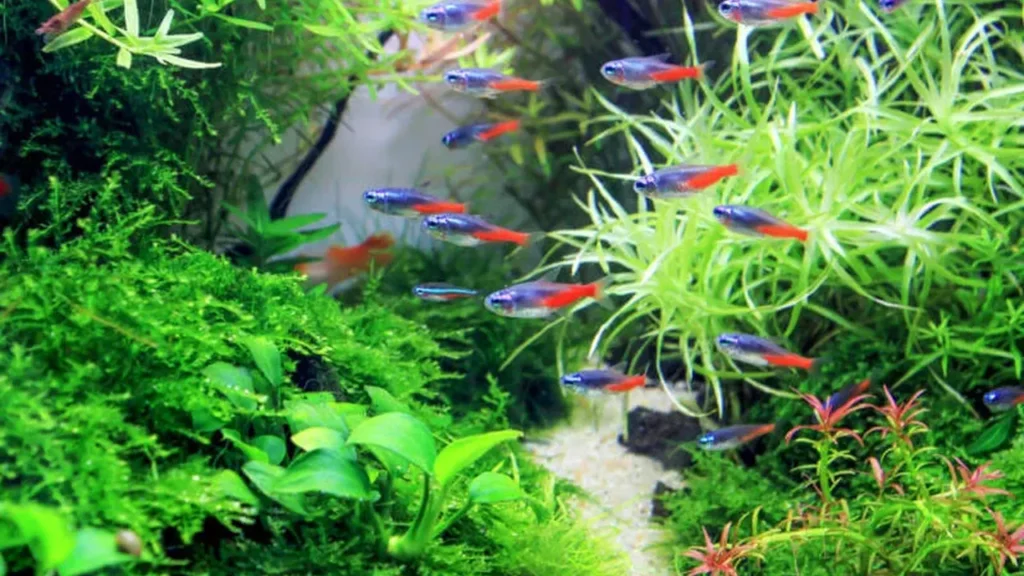
Neon Tetras
Just a mere glimpse of them might make one remember the vibrant streaks of light adorning the quiet nights of nature. These tiny and radiant fishes are known as *Paracheirodon innesi* in the scientific realm.
Neon tetras are widely recognized for their schooling nature. If you’ve ever had the joy of observing them in an aquarium, you might have seen them darting and swirling in cohesive units. Their harmony and synchronized moves are truly a sight to behold, reminiscent of a choreographed dance.
Their collective behavior isn’t just for show. Schooling is a survival instinct, allowing the neon tetras to appear larger to potential predators and confusing those who might see them as a snack. This behavior also demonstrates their social inclinations and the comfort they derive from being with their own kind.
Furthermore, these little gems possess a general peaceful temperament. They’re far from being aggressive and prefer co-existing in serenity with their fellow tank mates. It’s seldom you’ll find a neon tetra being the “bad fish” in the tank. While the question of aggression might pop up, such as with the Ember Tetra, neons generally keep to themselves and their school.
However, this peace-loving nature also means that neon tetras can sometimes become easy targets for more assertive or aggressive tank inhabitants. That’s why it’s crucial to understand their behaviors and needs, to ensure a harmonious environment for them and their potential tank mates, like the betta fish.
Bettas
These fish, often christened as Siamese Fighting Fish, carry an aura that is both elegant and fierce. If neon tetras are the ballet dancers of the aquatic world, bettas are the samurai, poised and full of character.
Now, let’s dive into their intriguing world. Bettas, especially males, are known for their aggressive tendencies. This reputation isn’t just folklore; it’s rooted in their very nature. Male bettas are territorial creatures, often guarding their chosen part of the water with a gusto that would make you think there’s an underwater kingdom at stake. This aggressive streak is predominantly directed towards other male bettas, stemming from an instinct to be the dominant fish and secure the best territories.
Historically, male bettas were often placed together in small containers for the sheer purpose of observing their confrontations. Though this practice isn’t conducive to the well-being of the fish, it highlights the natural predisposition of these creatures to be assertive and even aggressive under certain circumstances.
Female bettas, on the other hand, are generally less aggressive than their male counterparts. However, this doesn’t mean they’re pushovers. They too can show bouts of assertiveness, especially when they feel their space is being infringed upon.
Understanding a betta’s behavior is paramount for any aquarist. It’s not just about ensuring their well-being, but also about creating an environment where they can coexist harmoniously with other species, such as the neon tetra. After all, even a warrior can enjoy a peaceful moment in nature’s embrace, don’t you think?
Compatibility: Why It Can Work
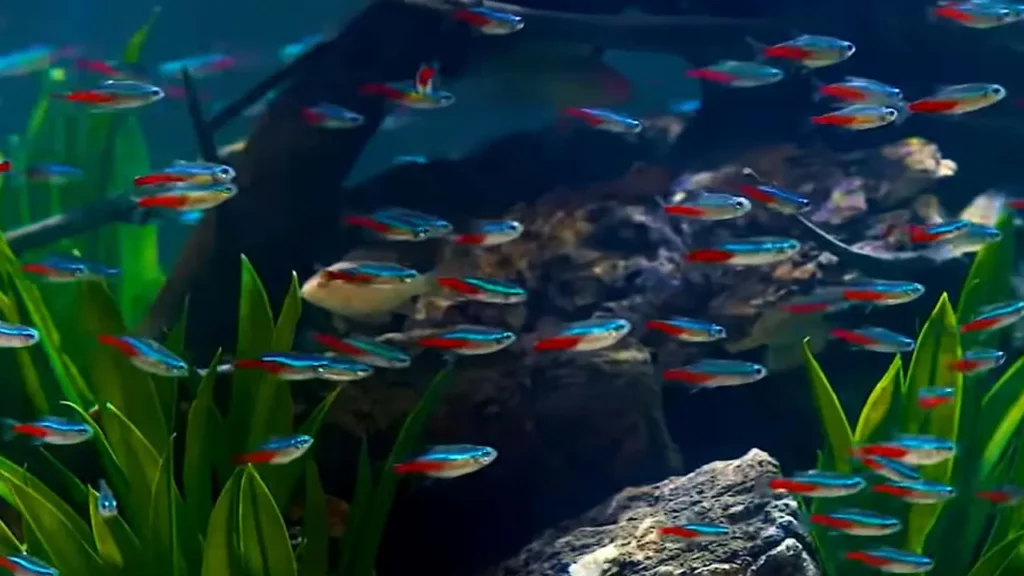
Distinct Swimming Zones
Nature, in its infinite wisdom, has designed the vast aquatic realm in layers, much like the stories of an age-old novel. Just as in our terrestrial world where birds have the sky and we have the ground, fish too have their preferred zones in the watery expanse.
Neon tetras, those dainty, shimmering wonders, generally favor the middle stratum of the water column. They thrive best when they can dart about in mid-water, their iridescent blues and reds casting miniature rainbows as they move. It’s almost as if they’re painting the water with their colors. This mid-water preference allows them a degree of freedom and safety, especially when they’re in their comforting schools.
On the other hand, bettas, with their majestic fins and assertive demeanor, often drift towards the surface. There’s something poetic about watching a betta fish hover near the water’s surface, occasionally gulping air (thanks to their labyrinth organ) or flaring their fins. Their surface preference is not just an aesthetic choice; it’s deeply rooted in their biology and behavior. The water surface is often their stage, a platform where they showcase their territorial displays and build their bubble nests.
This natural division of zones in the aquarium is a blessing in disguise. With neon tetras occupying the mid-water and bettas preferring the surface, their paths seldom cross. This spatial distinction greatly reduces the chances of confrontations or territory disputes, making the compatibility of these two species not just a dream, but a tangible reality.
But as any good aquarist knows, it’s not just about zones; it’s about understanding and respecting the sanctity of these zones to ensure harmony in the aquatic kingdom.
Neon tetras, with their petite size and subdued yet radiant colors, aren’t typically seen as threats in the eyes of a betta. While their vibrant stripe might catch our eye and make them stand out in the aquascaping world, it doesn’t scream “competition” to the betta. In the vast color spectrum of the underwater realm, neon tetras fall into the category of the unobtrusive.
Bettas, conversely, are flamboyant and proud. Their flowing fins and a plethora of colors make them the divas of freshwater tanks. In their eyes, bright, long-finned, and similarly sized fish might be perceived as rivals. Think of it as someone wearing the same elaborate outfit to a party. But neon tetras, with their modest size and different aesthetic, don’t register as ‘that rival’ in the betta’s perspective.
It’s like pairing a vibrant peacock with a delicate hummingbird. Both are undeniably beautiful in their own right, but they don’t compete for the same niche in the aesthetic landscape.
This non-competing appearance dynamic is crucial. It means that the betta is less likely to view the neon tetra as a challenger for territory or dominance, which in turn lowers the potential for aggressive confrontations. Instead, they can coexist, each offering a different kind of beauty to the observant eye, enriching the overall visual experience of the tank.
Non-Competing Appearances
In the world of fashion, we often hear that certain colors or styles clash, but in the vast and diverse tapestry of aquatic life, appearances play an even more vital role. How a fish looks can spell the difference between camaraderie and conflict.
Neon tetras, with their petite size and subdued yet radiant colors, aren’t typically seen as threats in the eyes of a betta. While their vibrant stripe might catch our eye and make them stand out in the aquascaping world, it doesn’t scream “competition” to the betta. In the vast color spectrum of the underwater realm, neon tetras fall into the category of the unobtrusive.
Bettas, conversely, are flamboyant and proud. Their flowing fins and a plethora of colors make them the divas of freshwater tanks. In their eyes, bright, long-finned, and similarly sized fish might be perceived as rivals. Think of it as someone wearing the same elaborate outfit to a party. But neon tetras, with their modest size and different aesthetic, don’t register as ‘that rival’ in the betta’s perspective.
It’s like pairing a vibrant peacock with a delicate hummingbird. Both are undeniably beautiful in their own right, but they don’t compete for the same niche in the aesthetic landscape.
This non-competing appearance dynamic is crucial. It means that the betta is less likely to view the neon tetra as a challenger for territory or dominance, which in turn lowers the potential for aggressive confrontations. Instead, they can coexist, each offering a different kind of beauty to the observant eye, enriching the overall visual experience of the tank.
Benefit of a School
The saying goes, “There’s strength in numbers,” and in the aquatic world, this wisdom holds particularly true for the delightful neon tetras.
As previously mentioned, neon tetras are schooling fish. This isn’t merely a preference or a whimsical choice. It’s an innate behavior, born from evolutionary necessity. When in a proper school, these small fish find solace, protection, and camaraderie. Imagine a harmonious aquatic ballet, where each dancer knows their part, lending support and drawing strength from the group.
But how does this schooling nature benefit them in the presence of a potential aggressor like the betta?
Well, for starters, a group of neon tetras swimming together presents a confusing visual for would-be aggressors. Their synchronized movements and collective size can deter potential threats, making them seem less like a group of individual targets and more like a singular, larger entity. In the mesmerizing dance of a neon tetra school, it becomes challenging for a betta or any other fish to single out one particular individual.
Furthermore, the school’s collective movement can help to diffuse and disperse any potential attention or interest from the betta. Instead of focusing on a single neon tetra, the betta’s attention might get divided amongst the group, reducing the likelihood of any targeted aggression.
For the neon tetras, being in a school offers a sense of safety, reducing stress and allowing them to exhibit natural behaviors. For the betta, the presence of a school can be a visual deterrent from displaying aggressive tendencies.
In essence, it’s not just about numbers, but the synergy these numbers create. A proper school of neon tetras is a shimmering shield, safeguarding each member while fostering harmony within the tank.
Potential Issues with Housing Together
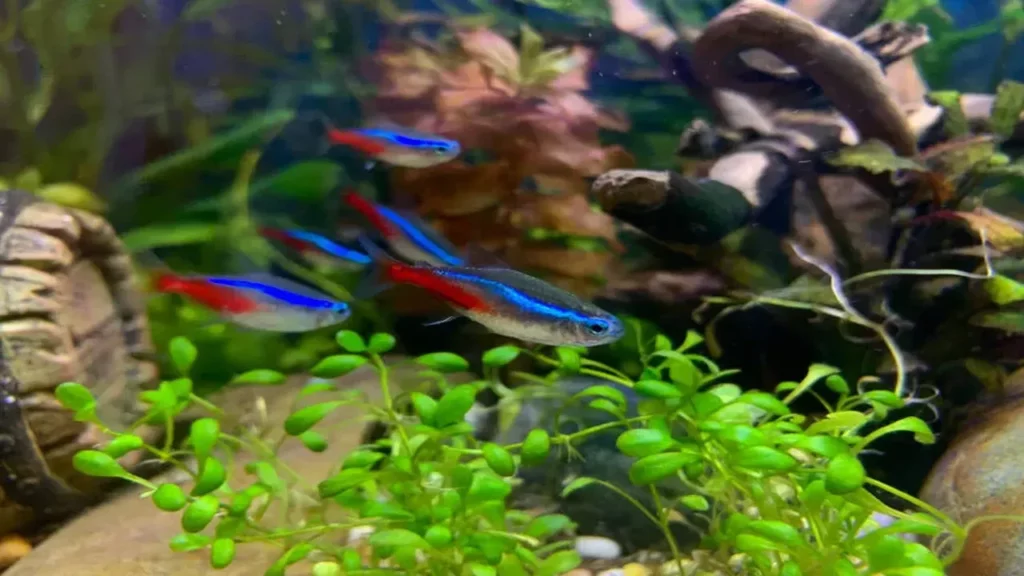
Individual Betta Temperaments
Just as we humans have our distinct personalities, our aquatic friends, particularly bettas, possess individual temperaments. While some might be the calm and contemplative philosophers of their aquatic realm, others can be fiery warriors, defending their territory with unparalleled zeal.
It’s essential to recognize that not all bettas are created equal in terms of aggression. Some may be naturally more tolerant and open to sharing their space with others, while some might wear their title of “Siamese Fighting Fish” with a certain pride, taking offense at the slightest intrusion into their perceived territories.
Factors influencing a betta’s temperament can range from genetics to previous living conditions. A betta that has spent most of its life in isolation might be less accustomed to sharing its space than one raised in a community tank. Moreover, certain triggers or past traumas, such as previous battles with other bettas or aggressive fish, can heighten their defensive instincts.
It’s also worth noting that even within the same betta, moods can fluctuate. Just as we might have our good days and bad days, a betta can have periods where it’s more accepting and other times when it’s more confrontational.
This unpredictable nature makes it crucial for aquarists to approach the idea of a shared tank with caution. While neon tetras might be generally compatible with bettas, individual betta temperaments can dictate the success or failure of such a pairing.
For someone passionate about fostering harmony in the underwater world, like yours truly, Benjamin Amano, understanding and respecting these individual temperaments is the key. After all, in the intricate dance of aquatic life, recognizing each participant’s rhythm and pace is essential.
Inadequate Space
The vast expanse of water, with its nooks and crannies, plays a pivotal role in the wellbeing and harmony of aquatic inhabitants. Dive with me, Benjamin Amano, into the importance of this element.
A smaller tank is akin to placing multiple vibrant personalities into a tiny room with no escape. The walls start closing in, personal bubbles are invaded, and suddenly, even the calmest of creatures might snap. The same goes for our aquatic buddies.
For a betta, a confined space amplifies its territorial instincts. Every corner of the tank becomes a treasured part of its kingdom, and any intrusion, even by the peaceful neon tetra, can be seen as a challenge. This heightened sense of territory in a cramped space can increase the likelihood of confrontations.
Neon tetras, while generally content in smaller groups, also thrive when they have adequate space to school and move freely. A smaller tank can restrict their natural behaviors, leading to increased stress levels. And as any good aquarist knows, stressed fish are more susceptible to illnesses and might even exhibit altered behaviors.
In essence, an inadequate space doesn’t just limit physical movement; it restricts the natural behaviors, rhythms, and harmonies that both bettas and neon tetras bring to the underwater tableau. It’s essential to ensure a spacious environment not just for the sake of aesthetics but for the mental and physical health of the tank’s inhabitants.
Breeding Behavior
Breeding, that age-old dance of life, brings forth not just new generations but also heightened instincts and behaviors. Let’s wade into the waters of the betta’s reproductive rituals, shall we?
When bettas enter their breeding phase, it’s like watching a dramatic aquatic opera unfold. Males become even more territorial, preparing bubble nests at the surface as an invitation for females. These bubble nests are a testament to their paternal instincts, safeguarding the future fry. However, with this parental commitment comes an intensified sense of ownership and defense.
During this period, the usually assertive betta becomes hyper-vigilant, guarding its nest with unparalleled fervor. Any perceived threat, be it from another betta or any other fish like the neon tetra, can trigger aggressive confrontations. The usually calm coexistence can quickly devolve into chase sequences and potential harm.
For the neon tetras, this increased aggression can be stressful. Even if they have no interest in the betta’s breeding activities, their mere presence in the vicinity of the nest can be seen as a threat. The betta’s heightened protective instincts might not discern between curious onlookers and potential nest disruptors.
It’s essential for aquarists to be aware of this behavioral shift during breeding. If one plans to breed bettas in a community tank, precautions need to be in place, such as temporary partitions or moving the betta to a separate breeding tank.
Life, in all its intricacies, presents challenges even in moments of creation. By understanding and respecting these nuances, we ensure that the circle of life in our aquatic havens remains unbroken and harmonious.
Recommendations for a Harmonious Tank
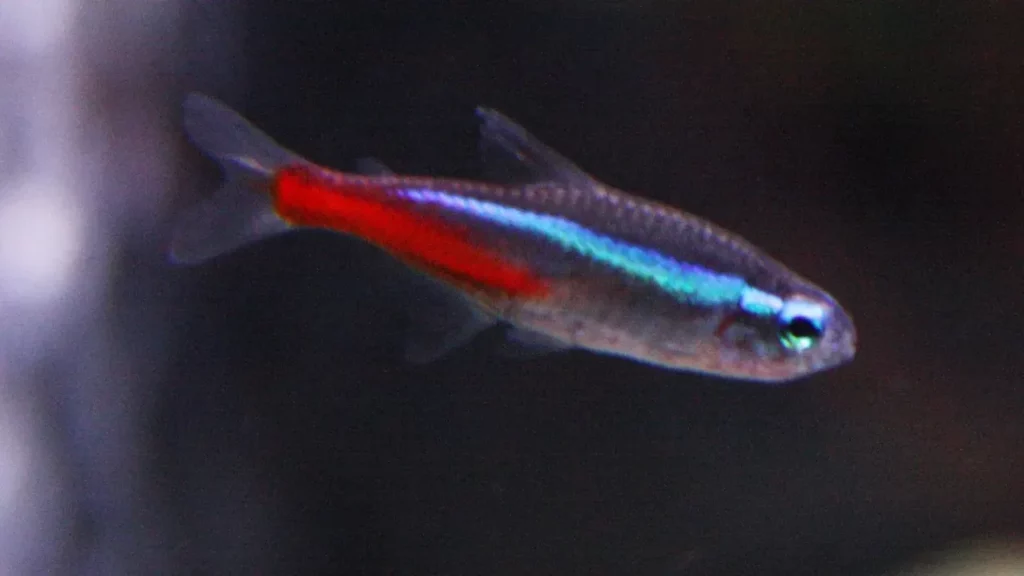
Sufficient Tank Size
The realm beneath the water’s surface is not just about flowing plants and glistening pebbles; it’s about space – an expanse where our aquatic companions can truly be themselves. Just as a painter needs a canvas and a writer a blank page, fish require ample space to paint their underwater stories.
Now, when we talk about housing both bettas and neon tetras, size truly does matter. Let’s navigate the watery dimensions together.
For a solitary betta, many might suggest a minimum of 2.5 to 5 gallons. However, when introducing neon tetras into the equation, one must consider their schooling nature and active swimming behavior. A 20-gallon tank would be a solid starting point for such a community. This size offers the bettas their territory while allowing the neon tetras enough space to school and exhibit their natural behaviors freely.
But why such a specific number? A 20-gallon tank provides ample horizontal swimming space, essential for tetras. The added volume also helps in diluting potential toxins and maintaining stable water parameters, essential for the health and well-being of both species.
Moreover, a larger water volume provides a buffer against rapid changes in water temperature, pH, and other factors, ensuring a more stable environment. This stability goes a long way in reducing stress for both bettas and neon tetras.
Proper Schooling of Neon Tetras
For neon tetras, schooling isn’t just a pastime; it’s a way of life. Schooling offers them protection, comfort, and social interaction. It’s like being part of a close-knit community, where each member supports the other, creating a harmonious aquatic symphony.
To ensure that your neon tetras experience this natural, comforting behavior, it’s crucial to maintain them in proper numbers. A group of six is often cited as the minimum, but in my experience, neon tetras truly thrive when kept in groups of 10 or more. In such numbers, they exhibit their most natural behaviors and appear more vibrant and active.
A larger school not only promotes confidence among the tetras but also reduces any undue attention they might receive from a curious betta. The more neon tetras there are, the less likely it is for the betta to focus on any single individual. It’s the collective strength and unity of the school that diffuses potential conflicts.
Furthermore, in a sufficiently sized tank, a larger group of neon tetras creates a mesmerizing visual spectacle. Their synchronized movements, punctuated by their radiant blue and red stripes, add an element of dynamic beauty to the tank.
Providing Hiding Spots and Plantation
Just as we humans cherish our cozy corners and private nooks, fish, too, benefit from hiding spots. These secluded areas offer them a respite from the bustling tank activities and a safe haven to retreat to during times of stress or perceived threats.
For bettas, plants, caves, and other decorations serve as markers of their territory. These landmarks help them define their personal space, and having multiple such spots can reduce their inclination to claim the entire tank.
Neon tetras, on the other hand, use these hideaways as a refuge. While they’re confident swimmers in their schools, they appreciate the occasional shelter, especially if they sense any aggressive intent from their tank mates.
Now, when we talk about plantations, live plants are a real treasure. Apart from their aesthetic beauty, they offer numerous benefits:
Oxygen Supply: Plants photosynthesize, providing essential oxygen to the tank inhabitants.
Natural Filters: They assist in absorbing nitrates and other waste products, promoting cleaner water.
Shelter and Shade: Tall plants, or those with broad leaves, offer resting spots for bettas and hiding spots for tetras.
Boundary Markers: Dense plantations can act as natural dividers, helping define territories within the tank.
Incorporating elements like driftwood, caves, or intricately designed decorations can further enhance the tank’s complexity. Such features not only add to the visual appeal but also break lines of sight, reducing direct confrontations between potentially aggressive tank mates.
Crafting a well-planned aquascape isn’t just about aesthetics. It’s about creating a balanced ecosystem that caters to the needs, comforts, and natural behaviors of its inhabitants. In this submerged Eden, every leaf, pebble, and hiding spot plays a part in weaving the tapestry of aquatic harmony.
Close Monitoring During Introduction
Introducing neon tetras to a betta’s realm (or vice versa) isn’t as simple as dropping them in and hoping for the best. This phase requires keen observation, patience, and sometimes, timely intervention.
Here’s a guide to ensure a smooth introduction:
Acclimatization: Before mixing the two species, allow the neon tetras to acclimate to the tank’s water parameters in a separate container. This not only ensures they’re in optimal health but also reduces the shock of a new environment.
Feeding First: Consider feeding your betta before the introduction. A satiated betta is less likely to exhibit aggressive behaviors out of hunger or irritation.
Distracting the Betta: Use a mirror or another distraction to divert the betta’s attention during the tetras’ introduction. It gives the neons time to explore without immediate scrutiny.
Observe the First Encounter: Keep a close eye on the initial interactions. Are they merely curious, or do you notice signs of aggression, like flaring gills or chasing?
Night-time Introduction: Introducing neon tetras during the evening or when the lights are dim can reduce the initial stress. Fish tend to be calmer during these periods, and by the time they’re fully active, they would’ve had time to adjust to each other’s presence.
Be Prepared to Separate: Despite all precautions, sometimes, personalities clash. If you notice prolonged aggression, consider separating the fish temporarily or rearranging the tank to break established territories.
Can Neon Tetra Live With Bettas Video Guide
Frequently Asked Questions – FAQ
Give Us Feedback
Please help us get better by making suggestions or giving feedback, we really do listen to it!
